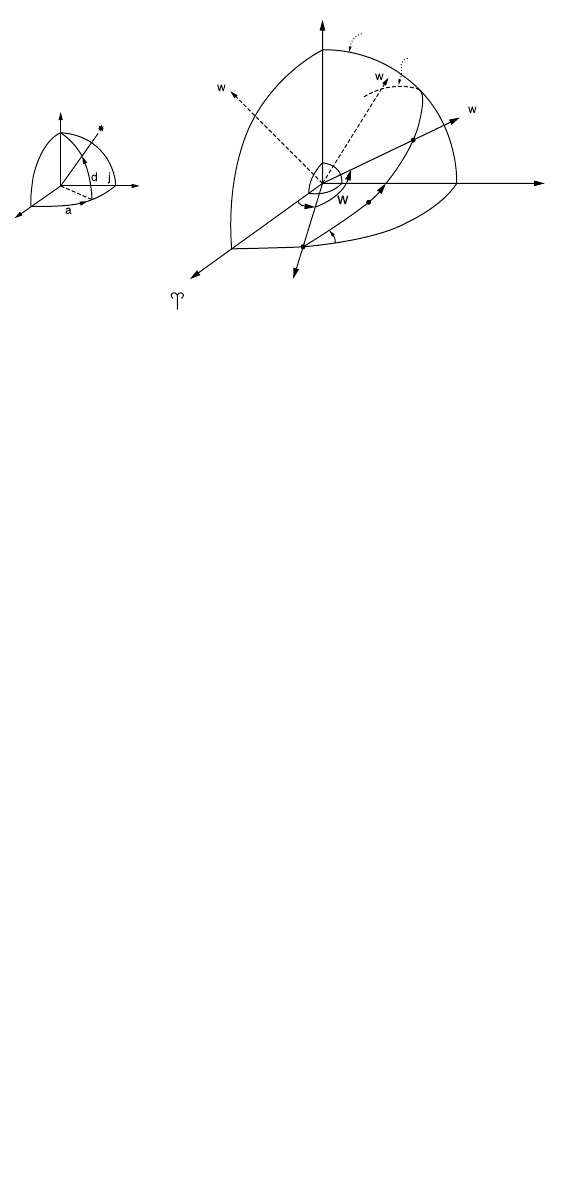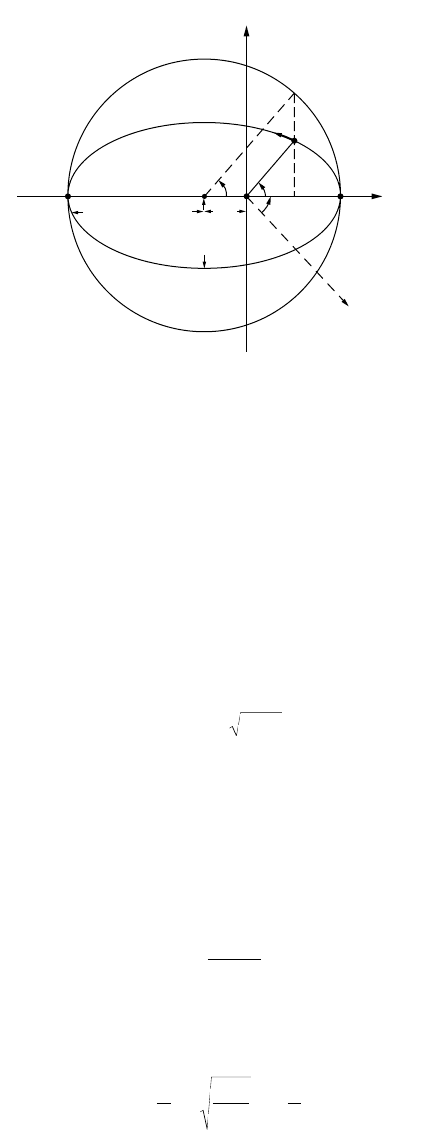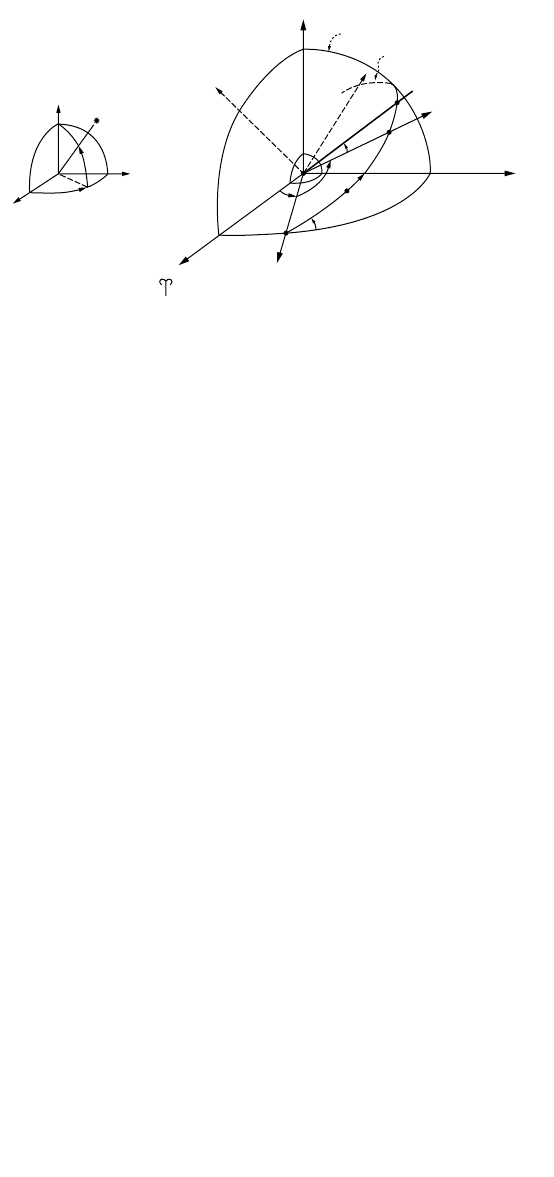Wai-Fah Chen.The Civil Engineering Handbook
Подождите немного. Документ загружается.


55-36 The Civil Engineering Handbook, Second Edition
or
(55.167)
with C = GM. Rather than solving for three second-order differential equations (DEs), we make a
transformation to six first-order DEs. Introduce three new variables U, V, W:
(55.168)
Equations (55.162) through (55.165) yield the following six DEs:
(55.169)
Integration of Eq. (55.169) results in six constants of integration. One is free to choose at an epoch t
0
six variables, {X
0
, Y
0
,
Z
0
,
U
0
,
V
0
,
W
0
} or {X
0
, Y
0
,
Z
0
,
·
X
0
,
·
Y
0
,
·
Z
0
}. These six starting values determine uniquely
the orbit of m around M. In other words, if we know the position {X
0
, Y
0
,
Z
0
} and its velocity {
·
X
0
,
·
Y
0
,
·
Z
0
}
at an epoch t
0
, then we are able to determine the position and velocity of m at any other epoch t by
numerical integration of Eq. (55.169).
Analytical Solution of Three Second-Order Differential Equations
The differential equations of an earth-orbiting satellite can also be solved analytically. Without derivation,
the solution is presented in computational steps in terms of transformation formulas.
In history the solution to the motion of planets around the sun was found before its explanation.
Through the analysis of his own observations and those made by Tycho Brahe, Johannes Kepler discovered
certain regularities in the motions of planets around the sun and formulated the following three laws:
1. Formulated 1609: The orbit of each planet around the sun is an ellipse. The sun is in one of the
two focal points.
2. Formulated 1609: The sun–planet line sweeps out equal areas in equal time periods.
3. Formulated 1611: The ratio between the square of a planet’s orbital period and the third power
of its average distance from the sun is constant.
Kepler’s third law leads to the famous equation
(55.170)
˙˙
˙˙
˙˙
/
/
/
XCXX Y Z
YCYX Y Z
ZCZX Y Z
=++
()
È
Î
Í
˘
˚
˙
=++
()
È
Î
Í
˘
˚
˙
=++
()
È
Î
Í
˘
˚
˙
222
32
222
32
222
32
UX
dX
dt
VY
dY
dt
WZ
dZ
dt
== == ==
˙
;
˙
;
˙
UX
VY
WZ
UCXX Y Z
VCYX Y Z
WCZX Y Z
=
=
=
=++
()
È
Î
Í
˘
˚
˙
=++
()
È
Î
Í
˘
˚
˙
=++
()
È
Î
Í
˘
˚
˙
˙
˙
˙
˙
˙
˙
/
/
/
222
32
222
32
222
32
na GM
23
=
© 2003 by CRC Press LLC

Geodesy 55-37
in which n is the average angular rate and a the semimajor axis of the orbital ellipse.
In 1665–1666 Newton formulated his more fundamental laws of nature (which were only published
after 1687) and showed that Kepler’s laws follow from them.
Orientation of the Orbital Ellipse
In a (quasi-)inertial frame the ellipse of an earth-orbiting satellite has to be positioned: the focal point
will coincide with the center of mass of the earth. Instead of picturing the ellipse itself we project the
ellipse on a celestial sphere centered at the CoM. On the celestial sphere we also project the earth’s equator
(see Fig. 55.18).
The orientation of the orbit ellipse requires three orientation angles with respect to the inertial frame
XYZ: two for the orientation of the plane of the orbit (W and I) and one for the orientation of the ellipse
in the orbital plane in terms of the point of closest approach, the perigee (w).
W represents the right ascension (a) of the ascending node. The ascending node is the (projected)
point where the satellite rises above the equator plane. I represents the inclination of the orbital plane
with respect to the equator plane. w represents the argument of perigee: the angle from the ascending
node (in the plane of the orbit) to the perigee (for planets, the perihelion), which is that point where
the satellite (planet) approaches closest to the earth (sun) or, more precisely, the CoM of the earth (sun).
We define now another reference frame X
w
, of which the X
w
Y
w
plane coincides with the orbit plane.
The X
w
axis points to the perigee, and the origin coincides with the earth’s CoM (∫ focal point ellipse ∫
origin of X frame). The relationship between the inertial frames X
I
and X
w
is
(55.171)
in which
(55.172)
and
(55.173)
FIGURE 55.18 Celestial sphere with projected orbit ellipse and equator.
Z
Y
X
=
Celestial sphere
Projected orbital ellipse
Perigee
X
Z
Y
Z
Y
i
Ascending node
X
Ω
X
II
= RX
??
RR R R
?3 1 3I
I=-
()
-
()
-
()
Ww
X
w
w
w
w
=
=
Ê
Ë
Á
Á
Á
Á
ˆ
¯
˜
˜
˜
˜
X
Y
Z 0
© 2003 by CRC Press LLC

55-38 The Civil Engineering Handbook, Second Edition
Reference Frame in the Plane of the Orbit
Now that we know the orientation of the orbital ellipse we have to define the size and shape of the ellipse
and the position of the satellite along the ellipse at a certain epoch t
0
.
Similarly to the earth’s ellipsoid, discussed in Section 55.2, we define the ellipse by a semimajor axis
a and eccentricity e. In orbital mechanics it is unusual to describe the shape of the orbital ellipse by its
flattening.
The position of the satellite in the orbital X
w
Y
w
plane is depicted in Fig. 55.19. In the figure the auxiliary
circle enclosing the orbital ellipse reveals the following relationships:
(55.174)
(55.175)
in which
(55.176)
In Fig. 55.19 and the Eqs. (55.174) through (55.176), a is the the semimajor axis of the orbital ellipse,
b is the semiminor axis of the orbital ellipse, e is the eccentricity of the orbital ellipse, with
(55.177)
n is the the true anomaly, sometimes denoted by an f, and E is the eccentric anomaly.
The relation between the true and the eccentric anomalies can be derived to be
(55.178)
Substitution of Eqs. (55.174) through (55.176) into (55.171) gives
FIGURE 55.19 The position of the satellite S in the orbital plane.
Apogee
a
b
ae
E
a
S
Perigee
X
w
Y
w
r
w
w
Ascending node
u
Xr a Ee
ww
n==-
()
cos cos
Yr a e E
ww
n==-sin sin1
2
ra eE
w
=-
()
1 cos
e
ab
a
2
22
2
=
-
tan tan
E
e
e2
1
12
Ê
Ë
Á
ˆ
¯
˜
=
-
+
Ê
Ë
Á
ˆ
¯
˜
n
© 2003 by CRC Press LLC

Geodesy 55-39
(55.179)
In Eq. (55.179) the Cartesian coordinates are expressed in the six so-called Keplerian elements: a, e,
I, W, w, and E. Paraphrasing an earlier remark: if we know the position of the satellite at an epoch t
0
through {a, e, I, W, w, and E
0
}, we are capable of computing the position of the satellite at an arbitrary
epoch t through the Eq. (55.179) if we know the relationship in time between E and E
0
. In other words,
how does the angle E increase with time?
We define an auxiliary variable (angle) M, which increases linearly in time with the mean motion
n (= (GM/a
3
)
1/2
) according to Kepler’s third law. The angle M, the mean anomaly, may be expressed as
function of time by
(55.180)
Through Kepler’s equation
(55.181)
the (time) relationship between M and E is given. Kepler’s equation is the direct result of the enforcement
of Kepler’s second law (equal area law).
Combining Eqs. (55.180) and (55.181) gives an equation that expresses the relationship between a
given eccentric anomaly E
0
(or M
0
or n
0
) at an epoch t
0
and the eccentric anomaly E at an arbitrary epoch t:
(55.182)
Transformation from Keplerian to Cartesian Orbital Elements
So far, the position vector {X, Y, Z} of the satellite has been expressed in terms of the Keplerian elements.
The transformation is complete when we express the velocity vector {
·
X
0
,
·
Y
0
,
·
Z
0
} in terms of those Keple-
rian elements. Differentiating Eq. (55.171) with respect to time we get
(55.183)
Since we consider the two-body problem with m
1
= M ? m = m
2
, the orientation of the orbital ellipse
is time independent in the inertial frame. This means that the orientation angles I, W, w are time
independent as well:
(55.184)
Equation (55.183) simplifies to
(55.185)
Differentiating Eqs. (55.174) through (55.176) with respect to time we have
(55.186)
XRRR
I313
=
Ê
Ë
Á
Á
Á
Á
ˆ
¯
˜
˜
˜
˜
=-
()
-
()
-
()
-
()
-
Ê
Ë
Á
Á
Á
Á
Á
ˆ
¯
˜
˜
˜
˜
˜
X
Y
Z
I
aEe
aeEWw
cos
sin1
0
2
MM ntt=+-
()
00
MEe E=-sin
EE e E E ntt-= -
()
+-
()
000
sin sin
˙˙˙
XRXRX
I? ? ? ?II
=+
˙
[]R
Iw
= 0
˙˙
XRX
I
=
I??
˙
˙
sin
X
w
=-aE E
© 2003 by CRC Press LLC

55-40 The Civil Engineering Handbook, Second Edition
(55.187)
(55.188)
The remaining variable
·
E is obtained through differentiation of Eq. (55.181):
(55.189)
Now all transformation formulas express the Cartesian orbital elements (state vector elements) in
terms of the six Keplerian elements:
(55.190)
or
(55.191)
(55.192)
Transformation from Cartesian to Keplerian Orbital Elements
To compute the inertial position of a satellite in a central force field, it is simpler to perform a time
update in the Keplerian elements than in the Cartesian elements. The time update takes place in Eqs.
(55.180) through (55.182).
Schematically the following procedure is to be followed:
The conversion from Keplerian elements to state vector elements has been treated in the previous
subsection. In this section the somewhat more complicated conversion from position and velocity vector
to Keplerian representation will be described. Basically we “invert” Eq. (55.192) by solving for the six
elements {a, e, I, W, w, E
0
} in terms of the six state vector elements.
˙
˙
cos
Y
w
=- -aE e E1
2
˙
˙
sinraEe E
w
=
˙
cos
E
n
eE
=
-1
XX R X X
II I
◊
[]
= ◊
[]
˙˙
ww w
XX
II
X
Y
Z
X
Y
Z
◊
[]
=
◊
◊
◊
È
Î
Í
Í
Í
Í
˘
˚
˙
˙
˙
˙
=
˙
˙
˙
˙
=-
()
-
()
-
()
-
()
◊
- ◊
◊
È
Î
Í
Í
Í
Í
Í
-
-
˘
˚
˙
˙
˙
˙
˙
RRR
313
W I
aEe
aeE
aE E
aE e Ew
cos
sin
˙
sin
˙
cos1
0
1
0
22
tXYZX
taeI
taeI
tXYZX
YZ
E
E
YZ
0
00
11
1
:,,,
˙
:,,,
:,,,
:,,,
˙
,
˙
,
˙
,,
,,
,
˙
,
˙
{}
Ø
{}
Ø
{}
Ø
{}
Conversion to Keplerian elements, this subsection
Conversion to Keplerian, Eq. (55.182)
Conversion to Cartesian elements, previous subsection
W
W
w
w
© 2003 by CRC Press LLC

Geodesy 55-41
First, we introduce another reference frame X
u
:
X
I
, Y
I
, Z
I
: inertial reference frame (X
I
axis Æ vernal equinox)
X
w
, Y
w
, Z
w
: orbital reference frame (X
w
axis Æ perigee)
X
u
, Y
u
, Z
u
: orbital reference frame (X
u
axis Æ satellite)
The X
u
frame is defined similarly to the X
w
frame, except that the X
u
axis continuously points to the
satellites (see Fig. 55.20). Thus,
(55.193)
The angle in the orbital plane enclosed by the X
u
axis and the direction to the ascending node is called
u, the argument of latitude, with
(55.194)
As in the discussion of the orientation of the orbit ellipse, the following relationships hold:
(55.195)
(55.196)
(55.197)
Figure 55.20 reveals that
(55.198)
(55.199)
(55.200)
FIGURE 55.20 The orbital reference frame X
u
.
Z
X
Y
a
d=j
Z
S
Y
X
u
Z
w
X
u
X
w
Y
w
Ω
i
w
Projected orbital ellipse
Celestial sphere
Perigee
Ascending node
X
X
Y
Z
X
0
0
u
u
u
u
u
=
Ê
Ë
Á
Á
Á
Á
ˆ
¯
˜
˜
˜
˜
=
Ê
Ë
Á
Á
Á
Á
ˆ
¯
˜
˜
˜
˜
uv=+w
XRX
ww
=
II
XRX
uuII
=
XRXRRX
uu uII
==
?? ??
RRRR
w
w
II
I=
() () ()
33
W
RRRR
uI I
uI=
() () ( )
33
W
=+
()
() ( )
RRR
33
vI
I
wW
© 2003 by CRC Press LLC

55-42 The Civil Engineering Handbook, Second Edition
(55.201)
(55.202)
We define a vector h perpendicular to the orbital plane according to
(55.203)
in which w is the unit vector along h. Consequently,
(55.204)
h represents the angular momentum vector (vector product of position vector and velocity vector). The
Keplerian elements W and I follow directly from Eqs. (55.203) and (55.204):
(55.205)
(55.206)
From
(55.207)
it follows that
(55.208)
(55.209)
and
(55.210)
Before determining the third Keplerian element defining the orientation of the orbit (w) from the
argument of latitude (u), we define the following quantities:
•Length r of the radius vector X:
(55.211)
=
() ( ) () ( )
RR RR
33 3
vI
I
wW
=
()
=RR RR
3
v
IuIwww
hXXhwh
I
∫ ¥= = -
Ê
Ë
Á
Á
Á
Á
ˆ
¯
˜
˜
˜
˜
˙
sin
sin
sin
cos
cos
W
W
I
I
h =
Ê
Ë
Á
Á
Á
Á
ˆ
¯
˜
˜
˜
˜
=
-
-
-
Ê
Ë
Á
Á
Á
Á
ˆ
¯
˜
˜
˜
˜
h
h
h
YZ ZY
ZX XZ
XY YX
1
2
3
˙
˙
˙
˙
˙˙
tan W=
-
h
h
1
2
tan I
hh
h
=
+
1
2
2
2
3
RXRRX
3I3I
-
()
=
() ( )
uI
u
W
XuX Y
u
cos cos sin=+WW
XuXI YI ZI
u
sin cos sin cos cos sin=- + +WW
tan
– cos sin cos cos sin
cos sin
u
XI YI ZI
XY
=
++
+
WW
WW
rXYZ∫ =++
()
X
222
12
© 2003 by CRC Press LLC

Geodesy 55-43
•Length
·
r of the radial component of the velocity vector:
(55.212)
The Vis-Viva equation gives the relationship between the length (magnitude) V of the velocity vector
·
X and the length r of the position vector X through the radial component (
·
r) and the tangential com-
ponent (r
·
v) (see Fig. 55.21):
(55.213)
From Eq. (55.213) it follows that
(55.214)
In a similar manner one arrives at
(55.215)
From Eqs. (55.188), (55.189), (55.176), and (55.170) the eccentric anomaly E may be computed:
(55.216)
The mean anomaly M is given by
(55.217)
The true anomaly v follows from Eqs. (55.174) and (55.175):
(55.218)
after which, finally, the last Keplerian element, w, is determined through Eq. (55.194):
(55.219)
FIGURE 55.21 Illustration of the Vis-Viva equation.
X
•
(V)
(ru
•
)
(r
•
)
u
CoM
X
Perigee
˙
˙
˙˙
˙
rrXXYYZZr∫◊ =++XX
VrrvrrGM
ra
2
2
222
2
2
21
∫ =+ =+ = -
Ê
Ë
Á
ˆ
¯
˜
˙
˙
(
˙
)
˙
Xh
a
GM
GM V
rGM
GM rV
=
-
=
-
X
X22
22
1
2
2
-=e
aGM
h
tan
sin
cos
˙
E
E
E
rr
e GMa
ar
ae
==
Ê
Ë
Á
ˆ
¯
˜
-
Ê
Ë
Á
ˆ
¯
˜
MEe E=-sin
tan
sin
cos
v
eE
Ee
=
-
-
1
2
w= -uv
© 2003 by CRC Press LLC

55-44 The Civil Engineering Handbook, Second Edition
Orbit of a Satellite in a Noncentral Force Field
The equations of motion for a real satellite are more difficult than reflected by Eq. (55.165). First of all,
we do not deal with a central force field: the earth is not a sphere, and it does not have a radial symmetric
density. Secondly, we deal with other forces, chiefly the gravity of the moon and the sun, atmospheric
drag, and solar radiation pressure. Equation (55.165) gets a more general meaning if we suppose that
the potential function is generated by the sum of the forces acting on the satellite:
(55.220)
with the central part of the earth’s gravitational potential
(55.221)
and the noncentral and time-dependent part of the earth’s gravitational field
(55.222)
and so forth.
The superscript t has been added to various potentials to reflect their time variance with respect to
the inertial frame.
The equations of motion to be solved are
(55.223)
For the earth’s gravitational field we have (in an earth-fixed frame)
(55.224)
With Eq. (55.224) one is able to compute the potential at each point {l, f, r} necessary for the
integration of the satellite’s orbit. The coefficients C
lm
and S
lm
of the spherical harmonic expansion are
in the order of 10
–6
, except for C
20
(l = 2, m = 0), which is about 10
–3
. This has to do with the fact that
the earth’s equipotential surface at mean sea level can be best approximated by an ellipsoid of revolution.
One has to realize that the coefficients C
lm
, S
lm
describe the shape of the potential field and not the shape
of the physical earth, despite a high correlation between the two. P
lm
sin f are the associated Legendre
functions of the first kind, of degree l and order m; a
e
is some adopted value for the semimajor axis
(equatorial radius) of the earth. See Section 55.8 for values of a
e
, m (= GM), and C
20
(= –J
2
).
The equatorial radius a
e
, the geocentric gravitational constant GM, and the dynamic form factor J
2
characterize the earth by an ellipsoid of revolution of which the surface is an equipotential surface.
Restricting ourselves to the central part (m = GM)
and the dynamic flattening (C
20
= –J
2
), Eq. (55.224)
becomes
(55.225)
with
(55.226)
in which f is the latitude and d the declination; see Fig. 55.20.
VV V V V
c
tt t
=+ + + +
nc sun moon
K
V
c
=m X
V
t
nc
see Eq. 52.224=
()
[]
˙˙
X =— + + + +
()
=— +— +— +— +
VV V V
VV V V
c
tt t
c
tt t
nc sun moon
nc sun moon
K
K
VV
r
a
r
CmSmP
c
lm
l
e
l
lm lm lm
+= +
Ê
Ë
Á
ˆ
¯
˜
+
()
()
È
Î
Í
Í
Í
˘
˚
˙
˙
˙
=
•
=
nc
m
llf1
10
SS cos sin sin
VV
r
Ja
r
cnc
e
+= + -
()
È
Î
Í
˘
˚
˙
m
f1
2
13
2
2
2
2
sin
sin sinfd==
()
z
r
© 2003 by CRC Press LLC

Geodesy 55-45
A solution of the DE (by substitution of Eq. (55.225) in Eq. (55.165))
(55.227)
in a closed analytical expression is not possible. The solution expressed in Keplerian elements shows
periodic perturbations and some dominant secular effects. An approximate solution using only the latter
effects is (position only)
(55.228)
with
(55.229)
with
(55.230)
(55.231)
(55.232)
(55.233)
whenever we have:
I = 0° equatorial orbit
0° < I < 90°direct orbit
I = 90° polar orbit
90° < I < 180° retrograde orbit
I = 180° retrograde equatorial orbit
Equation (55.230) shows that the ascending node of a direct orbit slowly drifts to the west. For a satellite
at a height of about 150 km above the earth’s surface the right ascension of the ascending node decreases
about 9º per day. For satellites used in geodesy and geodynamics, such as STARLETTE (a = 7340 km, I =
50°) and LAGEOS-I (a = 12,270 km, I = 110°), these values are –4° per day and +1/3° per day, respectively.
The satellites belonging to the Global Positioning System have an inclination of about 55°. Their nodal
regression rate is about –0.04187° per day.
The Global Positioning System
Introduction
The Navstar GPS space segment consists of 24 satellites, plus a few spare ones. This means that the full
satellite constellation, in six orbital planes at a height of about 20,000 km, is completed. With this number
of satellites, three-dimensional positioning is possible every hour of the day. However, care must be exercised,
since an optimum configuration for three-dimensional positioning is not available on a full day’s basis.
In the meantime, GPS receivers, ranging in cost between $300 and $20,000, are readily available. Over
100 manufacturers are marketing receivers, and the prices are still dropping. Magazines such as G.I.M.,
˙˙
X =— +
()
VV
c 20
XR R R X
313I
tI t=-+
()
-
()
-+
()
[]
[
˙
]
˙
WWD D
00
ww
w
Dttt=-
0
˙
cosW=-
-
()
3
2
1
2
2
22
2
Ja
ae
nI
e
˙
sinw=
-
()
-
Ê
Ë
Á
ˆ
¯
˜
3
2
1
2
5
2
2
2
22
2
2
Ja
ae
nI
e
nn
Ja e
ae
I
e
=+
-
-
()
-
Ê
Ë
Á
ˆ
¯
˜
È
Î
Í
Í
Í
˘
˚
˙
˙
˙
0
2
22
22
2
2
1
3
2
1
1
1
3
2
sin
n
GM
a
0
3
=
© 2003 by CRC Press LLC
